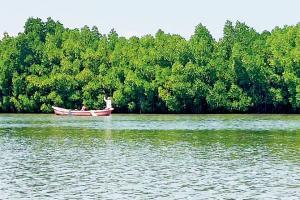A flashback visit to Tamil Nadus Pichavaram mangroves reminded us of the criticality of their existence and why this green heritage needs to be preserved in our city with renewed intent, now that Maharashtra has its official mangrove tree

The boat ride took us through Tamil Nadu's Pichavaram mangroves
 In August this year, Mumbai's greens had some reason to cheer when the state government announced that the white chippi (sonneratia alba) or sweet scented apple mangrove was declared as the official mangrove tree of Maharashtra. The state and the city can boast of its mangrove cover; however, it continues to be under constant threat due to development projects, not to forget, rampant encroachments.
In August this year, Mumbai's greens had some reason to cheer when the state government announced that the white chippi (sonneratia alba) or sweet scented apple mangrove was declared as the official mangrove tree of Maharashtra. The state and the city can boast of its mangrove cover; however, it continues to be under constant threat due to development projects, not to forget, rampant encroachments.
ADVERTISEMENT
In fact, a few weeks back, a news report had highlighted that while the state has 30,000 hectares of mangroves, only half of it is protected through survey methods like geo-tagging or physical marking, which means they are under direct threat from all kinds of devastation. That revelation made the mind take a little a fantasy leap [it can be a beautiful distraction especially in these times] to an earlier visit to the Pichavaram mangrove forests off Cuddalore in Tamil Nadu.
The trip was not even part of the day's original itinerary. Two history and heritage nuts were on a temple trail in Kumbakonam and Tanjore, but when the Lonely Planet threw up this little gem, it piqued us sufficiently. We were off to seek out this green treasure — India's second largest after Sundarbans. En route, the landscape, dotted by palm trees and Jayalalitha's giant cutouts, kept us engaged. Soon enough, blaring Tamil hits from vintage radios in tea shops and signboards screaming fresh catch reminded us that we were nearing a tourist hub. Gulp. Would it end up being a waste of an hour-long ride with a place filled with pesky, litter-crazed touristy folk? We exchanged glances. Much to our relief, it was quite the opposite. A relatively empty ticket area greeted us, and after a strict sari-clad amma handed us our life jackets, we along with six others, were off in a motorboat.
This 1,000-hectare stretch, we learnt later, shielded a large part of villages that lined this mangrove belt who escaped death from 2004's devastating tsunami. This ecosystem flows into the Bay of Bengal, and offers sustenance to inland fishermen of the area. A gentle breeze made us forget that it was well past noon. Egrets, kingfishers, and ducks kept the shutterbugs in the boat busy but what caught my attention was the lack of litter throughout the nearly 50-minute-long ride: no water bottles, disposed of tetrapak containers, chocolate wrappers or snack packets. I saluted the locals who were able to keep things under check. The boatman, egged on by our enthusiastic group, decided to give us a better view of a few inner water channels [of course, at a price]. At some points, the growth formed arches, and so we had to duck to ensure we didn't get entangled in it. It felt as if we were living a documentary set in a waterway buried deep inside a mangrove forest. The boatman was mindful to keep a safe distance from this precious cover, and negotiated the boat with great skill throughout our mini adventure in the heart of this mangrove. Being so close to nature in its purest form was a high that we're sure even the great Sir David Attenborough would've approved of.
Later, on my return to Bombay, I decided to do some reading up about this mangrove cover. It saddened me to learn that these locals were fighting a battle against an offshore drilling project about 500 metres from these forests that would create a definite threat to this fragile ecosystem. The green gatekeepers that saved its people from death were now staring at their own possible demise. Further poring over didn't reveal if that project took off, after all.
Either way, it acted as a reminder that be it on the east or west coast, both of which witnessed torrential rain and cyclones this year, protecting our mangrove cover ought to be top priority, because climate change is here, and will affect that smiling fisherman we waved back at in Pichavaram as much as the white-collared corporate staffer in his air-conditioned office in Fort. Saluting a state's mangrove species a good step, but our city in particular needs a lot more insurance cover from its caretakers and lawmakers, else the much-hailed move to have a state mangrove tree — India's first state to do so — might just be reduced to yet another act of green tokenism.
mid-day's Features Editor Fiona Fernandez relishes the city's sights, sounds, smells and stones...wherever the ink and the inclination takes her. She tweets @bombayana
Send your feedback to mailbag@mid-day.com
Keep scrolling to read more news
Catch up on all the latest Mumbai news, crime news, current affairs, and a complete guide from food to things to do and events across Mumbai. Also download the new mid-day Android and iOS apps to get latest updates.
Mid-Day is now on Telegram. Click here to join our channel (@middayinfomedialtd) and stay updated with the latest news
 Subscribe today by clicking the link and stay updated with the latest news!" Click here!
Subscribe today by clicking the link and stay updated with the latest news!" Click here!






